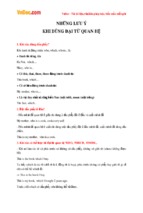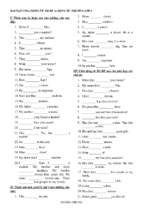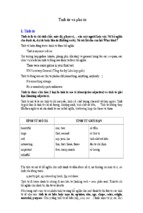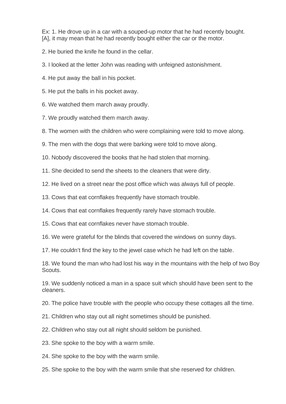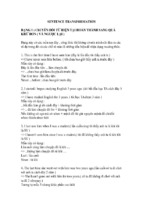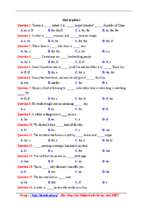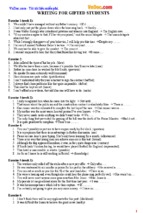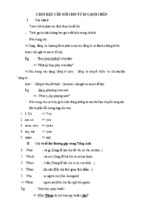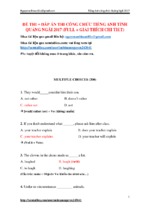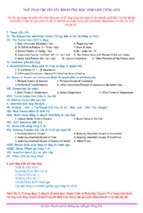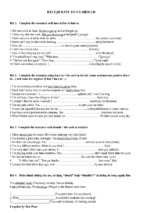1
TÀI LIỆU LUYỆN ĐỌC HIỂU
(Biên soạn: Hoàng Việt Hưng - Trick Master)
* Cách học:
- Đặt thời gian 15 phút cho bài 10 câu và 10 phút cho bài 5 câu.
- Làm qua 1 lượt không tra cứu rồi tra đáp án - nên đọc bài trước một lượt rồi mới
đọc câu hỏi.
(tốt nhất nên làm ra nháp và giữ bản photo sạch sẽ để còn làm lại LẦN 2)
- Mỗi ngày làm từ 1 - 2 bài. Hôm nào giải đề thì làm 1 bài, hôm nào học lẻ thì làm
2 bài.
- Quay lại làm chỗ này vào khoảng mùng 10 tháng 6.
- Không thể tra cứu hết được thì hãy cố tra cứu các từ mà vì không biết nó nên
mình làm sai.
- Hãy cố gắng TRA CỨU KỸ các bài sau:
Bài 1
Bài 2
Bài 3
Bài 7
Bài 11
Bài 13
Bí quyết làm đọc hiểu - thực ra Phương Hướng - là:
TỪ VỰNG và LUYỆN TẬP !
Bây giờ chỉ kịp nạp ít từ vựng nên cố gắng lấy Luyện Tập để bù lại !
Hãy chú ý từ vựng trong các bài đọc sách giáo khoa lớp 12 ! Đảm bảo HẾT SẠCH trong đó đi !
2
BÀI SỐ 1
Plants and animals will find it difficult to escape from or adjust to the effects of global
warming. Scientists have already observed shifts in the lifecycles of many plants and animats,
such as flowers blooming earlier and birds hatching earlier in the spring. Many species have
begun shifting where they live or their annual migration patterns due to warmer temperatures.
With further warming, animals will tend to migrate towards the poles and up
mountainsides towards higher elevations. Plants will also attempt to shift their ranges, seeking
new areas as old habitats grew too warm. In many places, however, human development will
prevent these shifts. Species that find cities or farmland blocking their way north or south may
become extinct. Species living in unique ecosystems, such as those found in polar and
mountaintop regions, are especially at risk because migration to new habitats is not possible.
For example, polar bears and marine mammals in the Arctic are already threatened by dwindling
sea ice but have nowhere farther north to go.
Projecting species extinction due to global warming is extremely difficult. Some scientists
have estimated that 20 to 50 percent of species could be committed to extinction with 2 to 3
Celsius degrees of further wanning. The rate of warming, not just the magnitude, is extremely
important for plants and animals. Some species and even entire ecosystems, such as certain
types of forest, may not be able to adjust quickly enough and may disappear.
Ocean ecosystems, especially fragile ones like coral reek, will also be affected by global
warming, warmer ocean temperatures can cause coral to "bleach", a state which if prolonged
will lead to the death of the coral. Scienists estimate that even 1 Celsius degree of additional
warming could lead to
widespead bleaching and death of coral reefs around the world. Also, increasing carbon dioxide
in the atmosphere enters the ocean and increases the acidity of ocean waters. This acidification
further stresses ocean ecosystems.
Question 1. Scientists have observed that warmer temperatures in the spring cause flowers
to.....
A. bloom earlier
B. lose color
C. die instantly
D. become lighter
Question 2: According to paragraph 2, when their habitats grow warmer, animals tend to
move.....
A. south-eastwards and down mountainsides towards tower elevations
B. north-westwards and up mountainsides towards higher elevations
C. towards the North Pole and down mountainsides towards tower etevattorts
D. towards the poles and up mountainsides towards higher elevations
Question 3: The pronoun “those” in paragraph 2 refers to.....
A. species
B. ecosystems
C. habitats
D. areas
Question 4: The phrase "dwindling sea ice" in paragraph 2 refers to.....
A. the frozen water in the Arctic
B. the cold ice in the Arctic
C. the violent Arctic Ocean
D. the melting ice in the Arctic
3
Question 5: It is mentioned in the passage that if the global temperature rose by 2 or 3 Celsius
degrees.....
A. water supply would decrease by 50 percent
B. the sea level would rise by 20 centimeters
C. 20 to 50 percent of species could become extinct
D. half of the earth's surface would be flooded
Question 6: According to the passage, if some species are not able to adjust quickly to
warmer temperatures,......
A. they may be endangered
B. they can begin to develop.
C. they will certainly need water
D. they move to tropical forests.
Question 7: The word “fragile” in paragraph 4 most probably means ..........
A. very large
B. easily damaged
C rather strong
D. pretty hard
Question 8: The bleaching of coral reefs as mentioned in paragraph 4 indicates ........
A. the water absorption of coral reefs
B. the quick growth of marine mammals.
C. the blooming phase of sea weeds
D. the slow death of coral reefs.
Question 9: The level of acidity in the ocean is increased by........
A. the rising amount of carbon dioxide entering the ocean
B. the decrease of acidity of the pole waters
C. the extinction of species in coastal areas.
D. the loss of acidity in the atmosphere around the earth
Question 10: What does the passage mainly discuss?
A. Influence of climate changes on human lifestyles.
B. Effects of global warming on animals and plants
C. Global warming and possible solutions
D. Global warming and species migration
BÀI SỐ 2
Upon the creation of the United States, one of the core concepts on which the hopes for the
new democracy were pinned was the ideal that its citizens would be enlightened individuals with
clearly articulated rights and the opportunity for individual achievement and education. It was
believed that in a free nation where the power belongs to the people, the commitment to education
defines the progress of that democracy and is the catalyst for future progress. This core value has
not only stood the test of time but has also grown in importance.
4
In this new Information Era and international economy, education is an increasingly vital
commodity, a precursor of potential success and a driving force of change. It is important to
recognize, however, that we approach education today differently than in the past, partly because
the kinds of jobs people had didn't require the kind of basic education and specialized training that
is often required in the workforce today. In the 1950s, for instance, only 20 percent of American
jobs were classified as professional, 20 percent as skilled, and 60 percent as unskilled. Today, our
world has changed. The proportion of unskilled jobs has fallen to 20 percent, while skilled jobs
now account for at least 60 percent of the workforce. Even more important, almost every job today
increasingly requires a combination of academic knowledge and practical skills that require
learning throughout a lifetime.
Question 1. Education is defined in this passage as a driving force of change because
.
A. without education, no changes could have happened in American society so far
B. the government of the United States want to drive social changes in their own ways
C. education has helped to bring about and orient most changes in the American workforce
D. any American citizen who wants to change his driving licence must be very well-educated
Question 2. The passage shows the percentage of jobs that require higher training in the US
between the 1950s and now.
A. has remained the same
B. has changed dramatically
C. has been reversed
D. has changed slightly
Question 3. The phrase "enlightened individuals" in the first sentence most likely means
"people who
."
A. always appear brilliant-looking in public
B. have often been well-exposed to light
C. have acquired an adequate level of education
D. bring light to anywhere they go
Question 4. In order to become a good American citizen today, in the author's point of view, any
individual must
.
A. know well all his/her rights and be ready to grasp his/her opportunity of success in life
B. study carefully the history of American educational and vocational systems even since their
creation
C. understand thoroughly the combination of academic knowledge and practical skills
D. move actively forward in the new Information Era and international economy with a
prestigious diploma
Question 5. Which of the following titles would be best for the passage?
A. Education and Jobs in the Past and at Present in the United States
B. The Significant Role of Education in American Citizens' Careers
C. Academic Knowledge and Practical Skills in American Professions
D. Recent Changes of Educational and Vocational Systems in America
5
BÀI SỐ 3
Overpopulation, the situation of having large numbers of people with too few resources
and too little space, is closely associated with poverty. It can result from high population density,
or from low amounts of resources, or from both. Excessively high population densities put stress
on available resources. Only a certain number of people can be supported on a given area of land,
and that number depends on how much food and other resources the land can provide. In
countries where people live primarily by means of simple fanning, gardening, herding, hunting,
and gathering, even large areas of land can support only small numbers of people because these
labour intensive subsistence activities produce only small amounts of food.
In developed countries such as the United States, Japan, and the countries of Western
Europe, overpopulation generally is not considered a major cause of poverty. These countries
produce large quantitics of food through mechanized farming, which depends on commercial
fertilizers, large-scale irrigation, and agricultural machinery. This form of production provides
enough food to support the high densities of people in metropolitan areas.
A country’s level of poverty can depend greatly on its mix of population density and
agricultural productivity. Bangladesh, for example, has one of the world’s highest population
densities, with 1,147 persons per sq km. A large majority of the people of Bangladesh engage
in low - productivity manual farming, which contributes to the country's extremely high level of
poverty. Some of the smaller countries in Western Europe, such as the Netherlands and Belgium,
have high population densities as well. These countries practise mechanized farming and are
involved in high-tech industries, however, and therefore have high standards of living.
At the other end of the spectrum, many countries in sub-Saharan Africa have population
densities of less than 30 persons per sq km. Many people in these countries practise manual
subsistence farming; these countries also have infertile land, and lack the economic resources
and technology to boost productivity. As a consequence, these nations are very poor. The United
States has both relatively low population density and high agricultural productivity; it is one of
the world's wealthiest nations.
High birth rates contribute to overpopulation in many developing countries. Children are
assets to many poor families because the provide labour, usually for farming. Cultural norms in
traditionally rural societies commonly sanction the value of large families. Also, the
governments of developing countries often provide little or no support, financial or political, for
family planning; even people who wish to keep their families small have difficulty doing so. For
all these reasons, developing countries lend to have high rates of population growth.
Question 1: Which of the following is given a definition in paragraph 1?
A. Overpopulation
B. Population density
C. Simple farming
D. Poverty
Question 2: What will suffer when there are excessively high population densities?
A. Available resources
B. Skilled labor
C. Farming methods
D. Land area
6
Question 3: The phrase "that number" in paragraph 1 refers to the number of ....
A. people
B. densities
C. resources
D. counlries
Question 4: In certain countries, large areas of land can only yield small amounts of food
because....
A. there is a lack of mechanization
B. there are small numbers of labourers
C there is on abundance of resources
D. there is no shortage of skilled labour
Question 5: Bangladesh is a country where the level of poverty depends greatly on
A. its population density only
B. both population density and agricultural productivity
C. population density in metropolitan areas
D. its high agricultural productivity
Question 6: The phrase “engage in” in paragraph 3 is closest in meaning to ........
A. escape from
B. look into
C. give up
D. participate in
Question 7: The word “infertile” in paragraph 4 probably means .......
A. disused
B. impossible
C. unproductive
D. inaccessible
Question 8: Which of the following is TRUE, according to the passage?
A. In certain developed countries, mechanized farming is applied.
B. In sub-Saharan African countries, productivity is boosted by technology.
C. There is no connection between a country’s culture and overpopulation.
D. All small countries in Western Europe have high population densities.
Question 9: Which of the following is a contributor to overpopulation in many developing
countries?
A. High-tech facilities
B. Economic resources
C. Sufficient financial support
D. High birth rate
Question 10: Which of the following could be the best title for the passage?
A. High Birth Rate and its Consequences
B. Overpopulation: A Cause of Poverty
C. Overpopulation: A Worldwide Problem
D. Poverty in Developing Countries
.
7
BÀI SỐ 4
Sometimes you know things about people the first time you see them, for example, that you
want to be friends with them or that you don't trust them. But perhaps this kind of intuition isn't as
hard to explain as it may seem. For instance, people give out body language signals all the time.
The way you hold your body, head and arms tells people about your mood. If you hold your arms
tightly at your sides, or fold them across your chest, people will generally feel that you are being
defensive. Holding your head to one side shows interest in the other, while an easy, open posture
indicates that you are self-confident. All this affects the way you feel about someone.
Also, a stranger may remind you of a meeting with someone. This may be because of
something as simple as the fact that he or she is physically similar to someone who treated you
well or badly. Your feelings about a stranger could be influenced by a smell in the air that brings
to mind a place where you were happy as a child. Since even a single word can bring back a
memory such as that, you may never realize it is happening.
Question 1. What does the word "open" in the passage most closely mean?
A. unrestrained
B. relaxed
C. confined
D. unlimited
Question 2. What influences your impression of a person you meet the first time?
A. Intuition.
B. Familiarity.
C. Knowledge.
D. Feeling.
Question 3. What one feels about a stranger may be influenced by something that
A. strengthens one's past behaviours
B. reminds one of one's past treatment
C. revives one's past memories
D. points to one's childhood
.
Question 4. What does the second paragraph discuss?
A. Meanings of signals one implies towards a stranger.
B. Factors that may influence one's feelings about a stranger.
C. How people usually behave to a stranger.
D. Factors that cause people to act differently.
Question 5. Intuition described in the passage can be explained by means of
A. styles
B. languages
C. patterns
D. behaviours
.
8
BÀI SỐ 5
Though called by sweet-sounding names like Firinga or Katrina, tropical cyclones are
huge rotating storms 200 to 2,000 kilometers wide with winds that blow at speeds of more than
100 kilometers per hour (kph). Weather professionals know them as tropical cyclones, but they
are called hurricanes in the Caribbean Sea, typhoons in the Pacific Ocean, and cyclones in the
Indian Ocean. They occur in both the northern and southern hemispheres. Large ones have
destroyed cities and killed hundreds of thousands of people.
Tropical cyclones begin over water that is warmer than 27 degrees Celsius (80 degrees
Fahrenheit) slightly north or south of the earth’s equator. Warm, humid air full of water vapor
moves upward. The earth’s rotation causes the growing storm to start to rotate around its center
(called the eye). At a certain height, the water vapor condenses, changing to liquid and releasing
heat. The heat draws more air and water vapor upward, creating a cycle as air and water vapor
rise and liquid water falls. If the cycle speeds up until winds reach 118 kilometers per hour, the
storm qualifies as a tropical cyclone.
Most deaths in tropical cyclones are caused by storm surge. This is a rise in sea level,
sometimes seven meters or more, caused by the storm pushing against the ocean’s surface.
Storm surge was to blame for the flooding of New Orleans in 2005. The storm surge of Cyclone
Nargis in 2008 in Myanmar pushed seawater nearly four meters deep some 40 kilometers inland,
resulting in many deaths.
It has never been easy to forecast a tropical cyclone accurately. The goal is to know when
and where the next tropical cyclone will form. “And we can’t really do that yet,” says David
Nolan, a weather researcher from the University of Miami. The direction and strength of tropical
cyclones are also difficult to predict, even with computer assistance. In fact, long- term forecasts
are poor; small differences in the combination of weather factors lead to very different storms.
More accurate forecasting could help people decide to evacuate when a storm is on the way.
Question 1: As stated in paragraph 1, tropical cyclones are storms with winds blowing at speeds
of
.
A. more than 100 kph
B. at least 200 kph
C. less than 100 kph
D. no less than 200 kph
Question 2: The word “they” in paragraph 1 refers to
.
A. sweet-sounding names
B. wind speeds
C. tropical cyclones
D. weather professionals
Question 3: According to the passage, tropical cyclones are called typhoons in
A. the Indian Ocean
B. the Arctic Ocean
C. the Atlantic Ocean
D. the Pacific Ocean
Question 4: The word “humid” in paragraph 2 is closest in meaning to
A. moist
B. dry
C. thin
.
.
D. thick
Question 5: Which of the following comes first in the process of storm formation?
A. Liquid water falls.
B. Warm, humid air moves upward.
C. Water vapor condenses.
D. Wind speed reaches 118 kph.
9
Question 6: According to the passage, a storm surge is
.
A. a rise in sea level
B. pushing seawater
C. a tropical cyclone
D. inland flooding
Question 7: What is true about the storm surge of Cyclone Nargis?
A. It took a very high death toll.
B. It caused flooding in New Orleans in
2005.
C. It occurred in Myanmar in 2005.
D. It pushed seawater 4 kilometers inland.
Question 8: The word “evacuate” in paragraph 4 mostly means
.
A. move to safer places
B. make accurate predictions
C. take preventive measures
D. call for relief supplies
Question 9: Which of the following statements is NOT true according to the passage?
A. The center of a growing storm is known as its eye.
B. The direction and strength of tropical cyclones are difficult to forecast.
C. Tropical cyclones are often given beautiful names.
D. Tropical cyclone predictions depend entirely on computer assistance.
Question 10: Which of the following would serve as the best title for the passage?
A. Cyclone Forecasting
B. Tropical Cyclones
C. Storm Surges
D. Cyclone Formation
10
BÀI SỐ 6
The concept of urban agriculture may conjure up images of rooftop, backyard or
community gardens scattered among downtown city streets and surrounding neighborhoods.
But in the Seattle area, and within and beyond the Puget Sound region, it means a great deal
more. “Urban agriculture doesn’t necessarily equate to production that occurs only in a
metropolitan urban area,” says Jason Niebler, who directs the Sustainable Agriculture
Education (SAgE) Initiative at Seattle Central Community College. “It means we are providing
for growing population food needs from surrounding rural landscapes, as well as from the core
urban landscape.”
Picture a series of concentric circles, with an urban core that produces some food at
varying capacities, surrounded by a series of outlying rings of small farms that become
increasingly more rural with distance. The hope is that such land use planning, from the inner
core to the outer rings, will encourage local ecologically sound sustainable food production.
This, in turn, will create local jobs and decrease reliance on distant food products that originate
from petroleum-intensive large scale farms.
That’s the idea behind SAgE, believed to be the nation’s first metropolitan-based
community college sustainable agriculture program that emphasizes farming practices across
diverse landscape types from urban centers to surrounding rural environs. “It’s small scale
agriculture with an urban focus,” Niebler says. “Any urban population, large or small, can
practice sustainable agriculture, improve food security and protect the environment, which
ultimately results in resilient food systems and communities.”
SAgE is a part of the National Science Foundation’s Advanced Technological Education
(ATE) Program, which is providing the project with $157,375 over two years. ATE’s goal is to
support projects that strengthen the skills of technicians who work in industries regarded as vital
to the nation’s prosperity and security. The support largely goes to community colleges that
work in partnership with universities, secondary schools, businesses and industries, as well
as government agencies, which design and implement model workforce initiatives.
The SAgE project focuses on the environmental, socioeconomic, political and cultural
issues related to sustainable food systems within Puget Sound watersheds through student and
community education and research, and technological innovation. The curriculum offers courses
that cover such issues as agricultural ecology, urban food systems, food politics and ethics, soil
science, sustainable food production and technology, the integration of food and forests, and
careeropportunities.
“We’ve created a curriculum that is fundamental in nature, addressing the principles of
sustainable agriculture and what a food system is – how it functions both locally and globally,”
Niebler says. “These courses are challenging, robust and inspirational. One of the really
wonderful things about them is that we offer service learning opportunities, where students
volunteer a portion of their time to working with local partner organizations. They can do a
research project, or a service learning option. The ideal would be to prompt students into careers
that involve sustainable practices in an urban agriculturesetting.”
11
Question 1: It is stated in the passage that Jason Niebler
A. preserves the core urban landscape
B. provides food for Seattle’s population
C. studies at Seattle Central Community College
D. directs the SAgE Initiative
.
Question 2: It can be inferred from the passage that the conventional idea of urban agriculture
.
A. focuses mainly on agriculture within and beyond the Puget Soundregion
B. aims at food production and consumption in both rural and urban regions
C. is associated with production only in metropolitan urbanareas
D. concerns with food production in any city’s surroundingareas
Question 3: The word “concentric” in paragraph 2 is closest in meaning to
A. coming from different places
B. having the same size
C. going in different directions
D. having the same center
.
Question 4: Which of the following is supposed to be an outcome of the SAgE’s new land use
planning?
A.Dependence on distant food products
B. Increased food production in large scale farms
C. Employment opportunities for local residents
D. Modernized farming practices in rural environs
Question 5: The phrase “in partnership with” in paragraph 4 probably means
.
A. together with
B. in addition to
C. in place of
D. instead of
Question 6: The curriculum of SAgE at Seattle Central Community College offers
courses covering the following EXCEPT
_.
A. agricultural ecology
B. career opportunities
C. urban system development
D. integration of food and forests
Question 7: In Niebler’s opinion, the courses offered by the SAgE project are
A. functional but impractical
B. robust but unpromising
C. challenging and costly
D. hard but encouraging
Question 8: The word “them” in paragraph 6 refers to
.
A. courses
B. opportunities
C. principles
D. students
Question 9: Which of the following is NOT true according to the passage?
A. The curriculum that the SAgE project designs is fundamental in nature.
B. The SAgE project alone will offer students sufficient jobs in urban agriculture.
C. ATE helps to improve the skills of technicians in the nation’s major industries.
D. Resilient food systems can be attributed to sustainable agricultural practices.
Question 10: Which of the following best describes the author’s tone in the passage?
A. Skeptical
B. Provocative
C. Supportive
D. Satirical
.
12
BÀI SỐ 7
The issue of equality for women in British society first attracted national attention in the
early 20th century, when the suffragettes won for women the right to vote. In the 1960s feminism
became the subject of intense debate when the women’s liberation movement encouraged women
to reject their traditional supporting role and to demand equal status and equal rights with men in
areas such as employment and pay.
Since then, the gender gap between the sexes has been reduced. The Equal Pay Act of
1970, for instance, made it illegal for women to be paid less than men for doing the same work,
and in 1975 the Sex Discrimination Act aimed to prevent either sex having an unfair advantage
when applying for jobs. In the same year the Equal Opportunities Commission was set up to help
people claim their rights to equal treatment and to publish research and statistics to show where
improvements in opportunities for women need to be made. Women now have much better
employment opportunities, though they still tend to get less well-paid jobs than men, and very few
are appointed to top jobs in industry.
In the US the movement that is often called the “first wave of feminism” began in the mid
1800s. Susan B. Anthony worked for the right to vote, Margaret Sanger wanted to provide women
with the means of contraception so that they could decide whether or not to have children, and
Elizabeth Blackwell, who had to fight for the chance to become a doctor, wanted women to have
greater opportunities to study. Many feminists were interested in other social issues.
The second wave of feminism began in the 1960s. Women like Betty Friedan and Gloria
Steinem became associated with the fight to get equal rights and opportunities for women under
the law. An important issue was the Equal Rights Amendment (ERA), which was intended to
change the Constitution. Although the ERA was not passed, there was progress in other areas. It
became illegal for employers, schools, clubs, etc. to discriminate against women. But women still
find it hard to advance beyond a certain point in their careers, the so-called glass ceiling that
prevents them from having high-level jobs. Many women also face the problem of the second shift,
i.e. the household chores.
In the 1980s, feminism became less popular in the US and there was less interest in solving
the remaining problems, such as the fact that most women still earn much less than men. Although
there is still discrimination, the principle that it should not exist is widely accepted.
Question 1: It can be inferred from paragraph 1 that in the 19th century,
A.
British women did not have the right to vote in political elections
B.
most women did not wish to have equal status and equal rights
C.
British women did not complete their traditional supporting role
D.
suffragettes fought for the equal employment and equal pay
Question 2: The phrase “gender gap” in paragraph 2 refers to
A.
the social distance between the two sexes
B.
the difference in status between men and women
C.
the visible space between men and women
D.
the social relationship between the two sexes
.
.
13
Question 3: Susan B. Anthony, Margaret Sanger, and Elizabeth Blackwell are mentioned as
.
A.
American women who had greater opportunities
B.
American women who were more successful than men
C.
pioneers in the fight for American women’s rights
D.
American women with exceptional abilities
Question 4: The Equal Rights Amendment (ERA)
.
A. supported employers, schools and clubs
B. was brought into force in the 1960s
C. was not officially approved
D. changed the US Constitution
Question 5: In the late 20th century, some information about feminism in Britain was issued
by
.
.
A. the Equal Pay Act of 1970
B. the Sex Discrimination Act
C. the Equal Opportunities Commission
D. the Equal Rights Amendment
Question 6: Which of the following is true according to the passage?
A.
The US movement of feminism became the most popular in the late 20th century.
B.
The women’s liberation movement in the world first began in Britain.
C.
The movement of feminism began in the US earlier than in Britain.
D.
The British government passed laws to support women in the early 20th century.
Question 7: The phrase “glass ceiling” in paragraph 4 mostly means
.
A. an overlooked problem
B. a ceiling made of glass
C. an imaginary barrier
D. a transparent frame
Question 8: Which of the following is NOT mentioned in the passage?
A.
Many American women still face the problem of household chores.
B.
An American woman once had to fight for the chance to become a doctor.
C.
British women now have much better employment opportunities.
D.
There is now no sex discrimination in Britain and in the US.
Question 9: It can be inferred from the passage that
.
A.
the belief that sex discrimination should not exist is not popular in the US
B.
women in Britain and the US still fight for their equal status and equal rights
C.
the British government did not approve of the women’s liberation movement
D.
women do not have better employment opportunities despite their great efforts
Question 10: Which of the following would be the best title for the passage?
A. Women and the Right to Vote
B. Opportunities for Women Nowadays
C. The Suffragettes in British Society
D. Feminism in Britain and the US
14
BÀI SỐ 8
Learning means acquiring knowledge or developing the ability to perform new
behaviors. It is common to think of learning as something that takes place in school, but much of
human learning occurs outside the classroom, and people continue to learn throughout their lives.
Even before they enter school, young children learn to walk, to talk, and to use their hands
to manipulate toys, food, and other objects. They use all of their senses to learn about the sights,
sounds, tastes, and smells in their environments. They learn how to interact with their parents,
siblings, friends, and other people important to their world. When they enter school, children learn
basic academic subjects such as reading, writing, and mathematics. They also continue to learn a
great deal outside the classroom. They learn which behaviors are likely to be rewarded and which
are likely to be punished. They learn social skills for interacting with other children. After they
finish school, people must learn to adapt to the many major changes that affect their lives, such as
getting married, raising children, and finding and keeping a job.
Because learning continues throughout our lives and affects almost everything we do, the
study of learning is important in many different fields. Teachers need to understand the best ways
to educate children. Psychologists, social workers, criminologists, and other human-service
workers need to understand how certain experiences change people’s behaviors. Employers,
politicians, and advertisers make use of the principles of learning to influence the behavior of
workers, voters, and consumers.
Learning is closely related to memory, which is the storage of information in the brain.
Psychologists who study memory are interested in how the brain stores knowledge, where this
storage takes place, and how the brain later retrieves knowledge when we need it. In contrast,
psychologists who study learning are more interested in behavior and how behavior changes as a
result of a person’s experiences.
There are many forms of learning, ranging from simple to complex. Simple forms of
learning involve a single stimulus. A stimulus is anything perceptible to the senses, such as a sight,
sound, smell, touch, or taste. In a form of learning known as classical conditioning, people learn
to associate two stimuli that occur in sequence, such as lightning followed by thunder. In operant
conditioning, people learn by forming an association between a behavior and its consequences
(reward or punishment). People and animals can also learn by observation - that is, by watching
others perform behaviors. More complex forms of learning include learning languages, concepts,
and motor skills.
Question 1: According to the passage, which of the following is learning in broad view
comprised of?
A.
Knowledge acquisition outside the classroom
B.
Acquisition of social and behavioural skills
C.
Knowledge acquisition and ability development
D.
Acquisition of academic knowledge
Question 2: According to the passage, what are children NOT usually taught outside the
classroom?
A. life skills
B. interpersonal communication
C. right from wrong
D. literacy and calculation
15
Question 3: Getting married, raising children, and finding and keeping a job are mentioned in
paragraph 2 as examples of
.
A.
the ways people’s lives are influenced by education
B.
the situations in which people cannot teach themselves
C.
the changes to which people have to orient themselves
D.
the areas of learning which affect people’s lives
Question 4: Which of the following can be inferred about the learning process from the passage?
A.
It is more interesting and effective in school than that in life.
B.
It plays a crucial part in improving the learner’s motivation in school.
C.
It becomes less challenging and complicated when people grow older.
D.
It takes place more frequently in real life than in academic institutions.
Question 5: According to the passage, the study of learning is important in many fields due to
.
A.
the need for certain experiences in various areas
B.
the exploration of the best teaching methods
C.
the influence of various behaviours in the learning process
D.
the great influence of the on-going learning process
Question 6: It can be inferred from the passage that social workers, employers, and politicians
concern themselves with the study of learning because they need to
.
A.
thoroughly understand the behaviours of the objects of their interest
B.
make the objects of their interest more aware of the importance of learning
C.
understand how a stimulus relates to the senses of the objects of their interest
D.
change the behaviours of the objects of their interest towards learning
Question 7: The word “retrieves ” in paragraph 4 is closest in meaning to _
A. recovers
B. gains
C. generates
D. creates
.
Question 8: Which of the following statements is NOT true according to the passage?
A.
Psychologists studying memory are concerned with how the stored knowledge is used.
B.
Psychologists studying memory are concerned with the brain’s storage of knowledge.
C.
Psychologists are all interested in memory as much as behaviours.
D.
Psychologists studying learning are interested in human behaviours.
Question 9: According to the passage, the stimulus in simple forms of learning
.
A. is created by the senses
B. bears relation to perception
C. is associated with natural phenomena
D. makes associations between behaviours
Question 10: The passage mainly discusses
.
A.
general principles of learning
B.
practical examples of learning inside the classroom
C.
simple forms of learning
D.
application of learning principles to formal education
16
ĐỀ SỐ 9
Millions of people are using cellphones today. In many places, it is actually considered
unusual not to use one. In many countries, cellphones are very popular with young people. They
find that the phones are more than a means of communication - having a mobile phone shows that
they are cool and connected.
The explosion in mobile phone use around the world has made some health professionals
worried. Some doctors are concerned that in the future many people may suffer health problems
from the use of mobile phones. In England, there has been a serious debate about this issue. Mobile
phone companies are worried about the negative publicity of such ideas.
They say that there is no proof that mobile phones are bad for your health. On the other hand,
medical studies have shown changes in the brain cells of some people who use mobile phones.
Signs of change in the tissues of the brain and head can be detected with modern scanning
equipment. In one case, a traveling salesman had to retire at young age because of serious memory
loss. He couldn't remember even simple tasks. He would often forget the name of his own son.
This man used to talk on his mobile phone for about six hours a day, every day of his working
week, for a couple of years. His family doctor blamed his mobile phone use, but his employer's
doctor didn't agree.
What is it that makes mobile phones potentially harmful? The answer is radiation. Hightech machines can detect very small amounts of radiation from mobile phones. Mobile phone
companies agree that there is some radiation, but they say
the amount is too small to worry about.
As the discussion about their safety continues, it appears that it's best to use mobile phones
less often. Use your regular phone if you want to talk for a long time. Use your mobile phone only
when you really need it. Mobile phones can be very useful and convenient, especially in
emergencies. In the future, mobile phones may have a warning label that says they are bad for your
health. So for now, it's wise not to use your mobile phone too often.
Question 1. According to the passage, cellphones are especially popular with young people
because
.
A. they keep the users alert all the time
B. they make them look more stylish
C. they are indispensable in everyday communications
D. they cannot be replaced by regular phones
Question 2. The changes possibly caused by the cellphones are mainly concerned with
.
A. the smallest units of the brain
B. the arteries of the brain
C. the mobility of the mind and the body
D. the resident memory
Question 3. The word "means" in the passage most closely means
.
A. method
B. meanings
C. expression
D. transmission
17
Question 4. The word "potentially" in the passage most closely means _
.
A. obviously
B. certainly
C. privately”
D. “possibly”
Question 5. "Negative publicity" in the passage most likely means
A. widespread opinion about bad effects of cellphones
B. the negative public use of cellphones
C. poor ideas about the effects of cellphones
D. information on the lethal effects of cellphones
.
Question 6. Doctors have tentatively concluded that cellphones may
A. change their users’ social behaviours
B. change their users’ temperament
C. cause some mental malfunction
D. damage their users’ emotions
.
Question 7. The man mentioned in the passage, who used his cellphone too often,
A. abandoned his family
B. suffered serious loss of mental ability
C. could no longer think lucidly
D. had a problem with memory
Question 8. According to the passage, what makes mobile phones potentially harmful is
.
A. their power of attraction B. their invisible rays
C. their radiant light D. their raiding power
Question 9. According to the writer, people should
A. keep off mobile phones regularly
B. only use mobile phones in medical emergencies
C. never use mobile phones in all cases
D. only use mobile phones in urgent cases
.
Question 10. The most suitable title for the passage could be
A. “Mobile Phones: A Must of Our Time”
B. “The Way Mobile Phones Work”
C. “Technological Innovations and Their Price”
D. “The Reasons Why Mobile Phones Are Popular”
.
.
18
ĐỀ SỐ 10
Commuting is the practice of travelling a long distance to a town or city to work each day,
and then travelling home again in the evening. The word commuting comes from commutation
ticket, a US rail ticket for repeated journeys, called a season ticket in Britain. Regular travellers
are called commuters.
The US has many commuters. A few, mostly on the East Coast, commute by train or
subway, but most depend on the car. Some leave home very early to avoid the traffic jams, and
sleep in their cars until their office opens. Many people accept a long trip to work so that they can
live in quiet bedroom communities away from the city, but another reason is ‘white flight’. In the
1960s most cities began to desegregate their schools, so that there were no longer separate schools
for white and black children. Many white families did not want to send their children to
desegregated schools, so they moved to the suburbs, which have their own schools, and where, for
various reasons, few black people live.
Millions of people in Britain commute by car or train. Some spend two or three hours a day
travelling, so that they and their families can live in suburbia or in the countryside. Cities are
surrounded by commuter belts. Part of the commuter belt around London is called the stockbroker
belt because it contains houses where rich business people live. Some places are becoming
dormitory towns, because people sleep there but take little part in local activities.
Most commuters travel to and from work at the same time, causing the morning and
evening rush hours, when buses and trains are crowded and there are traffic jams on the roads.
Commuters on trains rarely talk to each other and spend their journey reading, sleeping or using
their mobile phones, though this is not popular with other passengers. Increasing numbers of
people now work at home some days of the week, linked to their offices by computer, a practice
called telecommuting.
Cities in both Britain and the US are trying to reduce the number of cars coming into town
each day. Some companies encourage car pooling (called car sharing in Britain), an arrangement
for people who live and work near each other to travel together. Some US cities have a public
service that helps such people to contact each other, and traffic lanes are reserved for car-pool
vehicles. But cars and petrol/gas are cheap in the US, and many people prefer to drive alone
because it gives them more freedom. In Britain many cities have park-and-ride schemes, car parks
on the edge of the city from which buses take drivers into the centre.
Question 1: Which of the following definitions of commuting would the author of this passage
most probably agree with?
A.
Travelling for hours from a town or city to work in the countryside every day.
B.
Using a commutation ticket for special journeys in all seasons of the year.
C.
Regularly travelling a long distance between one’s place of work and one’s home.
D.
Travelling to work and then home again in a day within a rural district.
Question 2: The word “repeated” in paragraph 1 most probably means
A. buying a season ticket again
B. saying something again
C. happening again and again
D. doing something once again
.
19
Question 3: The passage mentions that many Americans are willing to travel a long distance to
work in order to be able to live in
.
A. quiet neighbourhoods
B. comfortable bedrooms
C. noisy communities
D. city centres
Question 4: Which of the following is true according to the passage?
A.
Britain has considerably more commuters than the US.
B.
The US has considerably more commuters than Britain.
C.
Commuting helps people in the US and Britain save a lot of time.
D.
Both the US and Britain have a great number of commuters.
Question 5: Which of the following is NOT true about the London commuter belt?
A. It surrounds London.
B. It is home to some wealthy business people.
C. It is in central London.
D. It is like “bedroom communities” in the US.
Question 6: It can be inferred from the passage that dormitory towns in Britain are places where
people
.
A. take part in local activities
B. contribute to the local community
C. are employed locally
D. stay for the night
Question 7: As mentioned in the passage, commuters usually
.
A. talk to each other during train journeys
B. cause traffic congestion on the roads
C. go home from work at different hours
D. go to work at different hours
Question 8: The phrase “linked to” in paragraph 4 is closest in meaning to
.
A. satisfied with
B. related to
C. connected to
D. shared with
Question 9: All of the following are measures to reduce the number of cars coming into town
each day in the US and/or Britain EXCEPT
.
A. free car parks in the city centre
B. car pooling/sharing
C. park-and-ride schemes
D. traffic lanes for car pooling
Question 10: The word “it” in the last paragraph refers to
A. travelling together
B. driving alone
C. car pool
.
D. petrol/gas
20
ĐỀ SỐ 11
It’s often said that we learn things at the wrong time. University students frequently do the
minimum of work because they’re crazy about a good social life instead. Children often scream
before their piano practice because it’s so boring. They have to be given gold stars and medals to
be persuaded to swim, or have to be bribed to take exams. But the story is different when you’re
older.
Over the years, I’ve done my share of adult learning. At 30, I went to a college and did
courses in History and English. It was an amazing experience. For starters, I was paying, so there
was no reason to be late – I was the one frowning and drumming my fingers if the tutor was late,
not the other way round. Indeed, if I could persuade him to linger for an extra five minutes, it was
a bonus, not a nuisance. I wasn’t frightened to ask questions, and homework was a pleasure not a
pain. When I passed an exam, I had passed it for me and me alone, not for my parents or my
teachers. The satisfaction I got was entirely personal.
Some people fear going back to school because they worry that their brains have got rusty.
But the joy is that, although some parts have rusted up, your brain has learnt all kinds of other
things since you were young. It has learnt to think independently and flexibly and is much better
at relating one thing to another. What you lose in the rust department, you gain in the maturity
department.
In some ways, age is a positive plus. For instance, when you’re older, you get less
frustrated. Experience has told you that, if you’re calm and simply do something carefully again
and again, eventually you’ll get the hang of it. The confidence you have in other areas – from being
able to drive a car, perhaps – means that if you can’t, say, build a chair instantly, you don’t, like a
child, want to destroy your first pathetic attempts. Maturity tells you that you will, with application,
eventually get there.
I hated piano lessons at school, but I was good at music. And coming back to it, with a
teacher who could explain why certain exercises were useful and with musical concepts that, at
the age of ten, I could never grasp, was magical. Initially, I did feel a bit strange, thumping out a
piece that I’d played for my school exams, with just as little comprehension of what the composer
intended as I’d had all those years before. But soon, complex emotions that I never knew poured
out from my fingers, and suddenly I could understand why practice makes perfect.
Question 1: It is implied in paragraph 1 that
.
A.
parents should encourage young learners to study more
B.
young learners are usually lazy in their class
C.
young learners often lack a good motivation for learning
D.
teachers should give young learners less homework
Question 2: The writer’s main point in paragraph 2 is to show that as people grow up,
.
A.
they have a more positive attitude towards learning
B.
they cannot learn as well as younger learners
C.
they tend to learn less as they are discouraged
D.
they get more impatient with their teachers
- Xem thêm -


